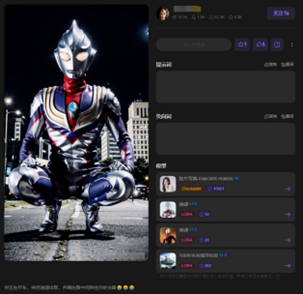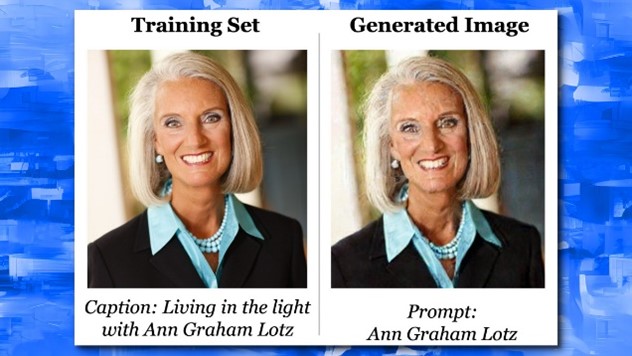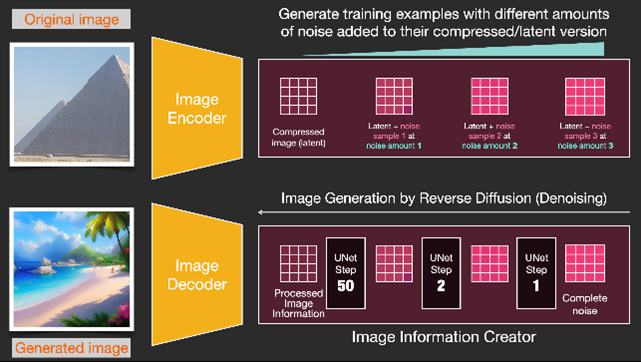I. Guangzhou Internet Court: Ultraman Case
The case received significant media attention as it marks the first ruling on AIGC in China, issued by the Guangzhou Internet Court in 2024. It would be beneficial to delve deeper into the complete judgment to gain insights into the judicial reasoning behind the classification of AIGC-generated works, particularly from the standpoint of copyright protection and the promotion of technology.
1. Summary from Ultraman Case Court Ruling
The defendant operates the Tab website, which offers features for AI dialogue and AI-generated artwork. The plaintiff has raised concerns after discovering that when using Tab to create images related to Ultraman—such as by entering the request "generate an image of Dyna Ultraman"—the resulting images bear a striking resemblance to the plaintiff's own Ultraman images. The plaintiff contends that the defendant has unlawfully utilized their copyrighted works without permission to train its large model, resulting in the generation of these similar images. Furthermore, the plaintiff alleges that the defendant has profited illegally through the sale of membership subscriptions and "computing power" purchases as additional services. This situation has caused significant harm to the plaintiff, prompting them to file a lawsuit to safeguard their legal rights.
2. Overview of Tab's Services
Tab's AI painting feature is exclusively available to members. During the online court hearing, the defendant indicated that Tab was launched in 2022, allowing paid users to access the membership version an unlimited number of times without restrictions on word count. Upon purchasing a membership, users receive a designated amount of "computing power," which is utilized for AI painting, with each session consuming 3 units of "computing power." Once this resource is depleted, users must recharge separately.
To support their claim that the images in question were sourced from a third-party service provider and that they did not use the plaintiff's Ultraman images for training, the defendant presented the "Order Agreement" signed with the third-party provider. Additionally, they provided screenshots of the interface information accessed from the third-party service provider's cloud service backend, commonly used interface details, the AI painting - basic version submission request page, and a screenshot of the user agreement from the third-party provider's cloud platform as evidence.

3. Court’s Opinion
1) Analysis of the Specific Content of Images Produced by the Tab
The plaintiff asserts that the Tab website, operated by the defendant, is capable of generating images that closely resemble the Ultraman character central to this case. They further contend that the AI drawing feature, which is exclusive to members, necessitates the use of specific "computing power" for each image created.
To support their claim of infringement on their rights to reproduction, adaptation, and dissemination of information via networks, the plaintiff has provided screenshots of images generated by the defendant's Tab website based on specific prompts. A comparison of the original composite image of Diga Ultraman with the main screenshot produced by the Tab website indicates that the generated images maintain the distinctive expressive qualities of the Ultraman artistic representation.
The defendant offers generative artificial intelligence services through the Tab website, and the products generated during this process display a significant degree of similarity to the Ultraman character in several key aspects, thereby constituting substantial similarity.
2) Measures Taken by the Defendant After Responding to the Case
During the court hearing, it was noted that when a prompt containing "Ultraman" was entered into the AI drawing module on the Tab website, a notification appeared stating, "The information you sent contains non-compliant content," preventing any image generation from occurring. Conversely, when the term "Diga" was used, the resulting image generated by Tab's AI drawing module bore a striking resemblance to the original Ultraman character involved in the case.
Prior to the trial, it was observed that there were no user agreements or platform guidelines available on the defendant's Tab website. Furthermore, there was no indication for users regarding the importance of respecting copyright or other legal rights while utilizing the service. Additionally, the website did not clarify that the images produced were generated by AI, nor did it inform users that the AI drawing feature was powered by a third-party service provider.
3) Did the defendant infringe upon the plaintiff's rights to reproduction, adaptation, and information network dissemination?
The Ultraman works in question are widely recognized and can be accessed, reviewed, and downloaded on prominent video platforms such as iQIYI. In the absence of any evidence to the contrary from the defendant, it is reasonable to assume that the defendant had access to these Ultraman works. The images submitted by the plaintiff, which were generated by the Tab website, either partially or fully replicate the original artistic expression of the character "Ultraman." Consequently, the defendant reproduced the Ultraman works without authorization, thereby infringing upon the plaintiff's right to reproduce these works.
The generated images in question retain elements of the original expression from the "Dyna Ultraman Composite" work while also exhibiting new characteristics derived from that original expression. As such, the defendant's actions can be classified as an adaptation of the Ultraman works. Therefore, the defendant adapted the Ultraman works without permission, infringing upon the plaintiff's right to adapt these works.
The determination of whether the defendant infringed upon the rights of reproduction and adaptation, as well as the right to disseminate information over networks, involves identifying the specific copyright rights that were violated. This assessment does not alter the fundamental nature of the infringement itself, nor does it significantly impact the rights holder or the public interest. Given the plaintiff's claim of a distinct infringement concerning the right to information network dissemination and considering that this case presents a novel situation of infringement related to generative artificial intelligence, the court has already upheld the claims regarding the infringement of reproduction and adaptation rights. Therefore, the court will refrain from conducting a redundant evaluation, as the same alleged infringing behavior has already been addressed under the reproduction and adaptation rights.
4. Judicial trend from Ultraman case
As artificial intelligence is still an emerging field, the Ultraman case is notable as the first copyright infringement case involving an AIGC platform. While it does not completely align with previous cases, it serves as an important reference for defining the responsibilities of generative AI platforms in future legal matters. The central issue in the Ultraman case focused on the nature of the defendant's actions. Although the defendant was not the direct operator of the infringing images, the court acknowledged that generative AI platforms operate similarly to network service providers, given their instrumental and service-oriented characteristics.
Consequently, the court determined that these platforms are special network service providers with substantial control over their operations and, therefore, bear a heightened duty of care. Ultimately, the court concluded that the AI platform's lack of reasonable care resulted in the plaintiff's losses, for which the plaintiff should be held accountable.
II. Beijing Internet Court: Stable Diffusion Case
1. Concerning the Criteria for "Intellectual Achievements"
"Intellectual achievements" encompass the outcomes of intellectual endeavors, and as such, the works produced should demonstrate the intellectual contributions of individuals. In this context, when the plaintiff shared the images in question, they were clearly identified as "AI illustrations." The plaintiff has the capability to utilize the Stable Diffusion model to replicate the image generation process by employing their own specific prompts and parameters. In the absence of any evidence to the contrary, it can be concluded that the image titled "Spring Breeze Brings Gentle Warmth" was indeed generated by the plaintiff using generative artificial intelligence technology.
2. What Stable Diffusion can achieve?
Based on publicly accessible information and relevant studies, the Stable Diffusion model is trained on a vast array of images and their associated textual descriptions sourced from the internet. This model is designed to create images that correspond to textual information by leveraging the relationship between the semantic content of the text and the visual elements of the image.
It is important to note that the image is not produced by retrieving existing images through a search engine, nor is it simply a rearrangement of pre-defined elements set by the software designer. In essence, the functionality of this model parallels that of humans who, through learning and experience, develop specific abilities and skills. It can generate images that align with textual descriptions provided by users, thereby eliminating the need for manual drawing and coloring, and effectively showcasing human creativity and ideas.
In this scenario, the plaintiff aimed to create a close-up image of a beautiful woman, utilizing a photographic style that captures the essence of dusk lighting. They entered specific prompt words into the Stable Diffusion model, designating the art type as "hyper-realistic photo" and "color photo," with the subject identified as a "Japanese idol." The plaintiff provided detailed descriptions regarding skin condition, eye color, and braid color, while the setting was characterized as "outdoor," "golden hour," and "dynamic lighting." The subject's presentation was described as having a "cool pose" and "looking at the camera," incorporating styles such as "film texture" and "film simulation." After establishing relevant parameters and reviewing the initially generated images, the plaintiff refined their prompts and adjusted the parameters, ultimately selecting an image that met their satisfaction.
3. Achievement of Stable Diffusion qualified as intellectual achievement
The entire process, from the initial conception of the image to the final selection, involved significant intellectual investment. This included designing the character's presentation, choosing and ordering prompt words, setting parameters, and determining which image aligned with their vision. As such, the resulting image reflects the plaintiff's intellectual effort, qualifying it as an "intellectual achievement."
However, it is important to note that not all intellectual achievements are classified as works; only those that demonstrate "originality" can be considered as such. "Originality" necessitates that the work is independently created by the author and showcases their unique expression. Works that are produced through a predetermined sequence, formula, or structure may yield similar results for different individuals, thus lacking the uniqueness required for originality. The determination of whether images generated by artificial intelligence embody the author's personalized expression must be assessed on a case-by-case basis, rather than generalized. Generally, when individuals utilize models like Stable Diffusion to create images, the more distinct their requests are from others, along with the clarity and specificity of their visual descriptions and layout compositions, the more likely they are to reflect their individual expression.
4. The image generation process and the role of the plaintiff herein
In this case, the images in question exhibit distinct differences from previous works. From the perspective of the image generation process, it is important to note that while the plaintiff did not physically draw specific lines or provide the Stable Diffusion model with a comprehensive description for creating those lines and colors, the model itself primarily "generated" the lines and colors that constitute the images. This approach differs significantly from traditional methods where artists use brushes or drawing software. However, the plaintiff played a crucial role in designing elements of the images, such as the characters and their presentation, by utilizing prompt words and establishing parameters for layout and composition. This reflects the plaintiff's creative choices and arrangements. Furthermore, after generating the initial image through the input of prompt words and relevant parameters, the plaintiff continued to refine the image by adding new prompt words and adjusting parameters, showcasing their aesthetic preferences and personal judgment throughout the process.
During the trial, the plaintiff demonstrated the ability to create various images by altering individual prompt words or parameters. This clearly illustrates that different individuals can input unique prompt words and set new parameters to produce diverse content using this model. Consequently, the images in question cannot be classified as "mechanical intellectual achievements." In the absence of any contrary evidence, it can be concluded that the images were independently created by the plaintiff, reflecting their unique expression. In summary, the images in question fulfill the criteria for "originality."


5. Court’s comments on AIGC from judicial perspective
The Court commented in the ruling as below:
As of October 2023, we are witnessing a remarkable rise in the use of generative artificial intelligence technology for creative endeavors. Tools such as Stable Diffusion and similar models are capable of producing stunning images from textual descriptions, enabling individuals—regardless of their artistic skills—to bring their ideas and designs to life. This advancement has significantly enhanced the efficiency of image creation.
It's important to recognize that generative AI is transforming the creative process in a manner akin to many historical technological innovations. The evolution of technology often involves delegating tasks traditionally performed by humans to machines. For instance, prior to the invention of the camera, exceptional painting skills were necessary to capture the likeness of real-world objects. The introduction of the camera simplified this process, and today, the advanced and user-friendly camera features of smartphones allow anyone to create photographic works. As long as these images reflect the photographer's unique intellectual contribution, they are protected under copyright law.
As technology continues to evolve and tools become increasingly sophisticated, the reliance on human input may diminish. However, this shift does not undermine our commitment to the copyright system, which plays a vital role in fostering the creation of new works. Historically, individuals invested time and effort in mastering painting techniques or commissioning artists to produce artwork. In such cases, clients would outline their specific requirements, and the commissioned artist would create the piece, infusing it with their own creativity and judgment. Typically, the commissioned artist is recognized as the creator in this scenario. This situation bears some resemblance to the use of artificial intelligence models for image generation, yet a key distinction exists: commissioned artists possess free will and actively incorporate their decisions into their work. In contrast, generative AI models currently lack free will and are not recognized as legal entities. Consequently, when individuals utilize AI models to create images, the question of authorship is straightforward; it remains a person employing a tool for creation, with the intellectual contribution stemming from the individual rather than the AI.
The primary objective of the copyright system is to encourage creativity. By effectively applying copyright principles and leveraging appropriate legal frameworks, we can inspire more individuals to create using the latest technologies, thereby promoting both artistic expression and advancements in artificial intelligence. In this context, as long as AI-generated images reflect the original intellectual contributions of a person, they should be acknowledged as works deserving of copyright protection.
